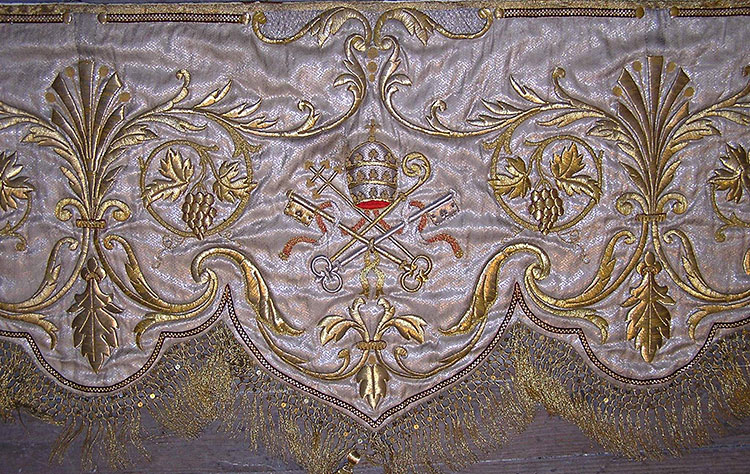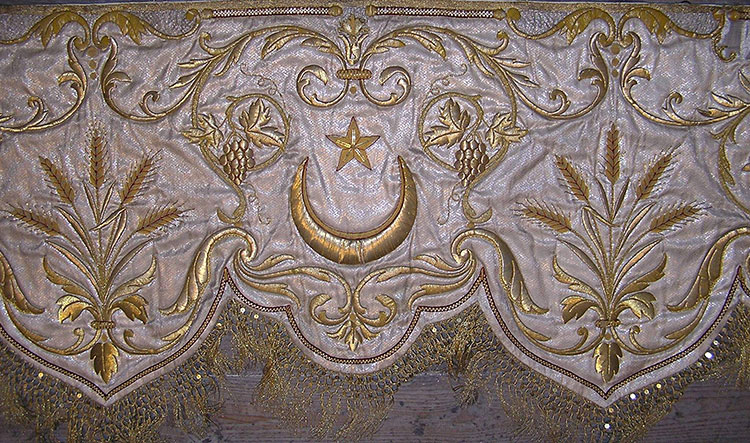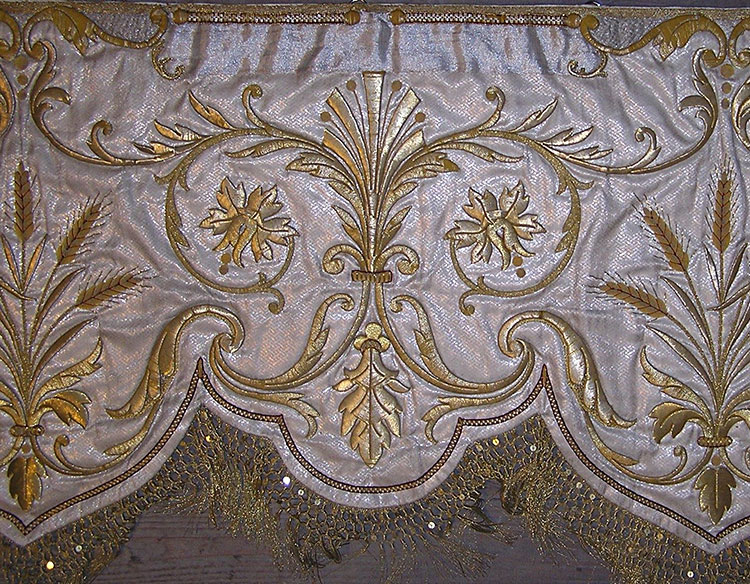The piece of the month of September 2024
1856 GOLD EMBROIDERED PALLIUM OF THE PARISH OF SAN SATURNINO DE PAMPLONA
Alicia Andueza Pérez
Chair of Navarrese Heritage and Art
This canopy, prepared to be carried with six rods, is formed by a white satin sky of modern invoice and silver fabric falls richly embroidered in gold. The fabric of the falls is a silver fabric of great richness that presents a fine pattern of woven threads. In the inner part of the sky appears a monstrance with the anagram IHS in the center and on a white cloud. It is embroidered with a certain relief and made with silver and gold threads. In turn, the front falls present a decoration based on vegetal bouquets that welcome bunches of grapes and ears of wheat and that show in their central part a papal tiara, patriarchal cross with double crossbar and the keys of St. Peter, one of gold and the other of silver, keys of heaven and earth as a symbol of the power to bind and unbind. In the lateral falls and among the same decorative motifs, it is the coat of arms of the parish of San Cernin with the star and the average moon that occupies the central part of the fall.

The different embroideries are made in several stitches of plain gold with some relief, like setillos and cobblestones. These stitches are based on a parallel series of cotton threads on which several round twines are stretched, which are joined together and fastened to the canvas with anarajanda silk stitches in the spaces left free by the cotton threads, creating a checkerboard decoration. On the other hand, most of the leaves and bouquets are made in piqué embroidery, in which the thread alternately covers the front and back of the fabric, while some stitches are formed by means of gold cord.
A border in the form of a checkered retort, topped by red silk, runs along the lower part of the falls and some areas of the upper part. The same red silk also appears outlining some decorative motifs, such as bunches of grapes. Likewise, in the upper part and between the fragments in which the aforementioned border is arranged, some areas have a mesh of silver threads. The satin bank lining is from invoice later, as well as some appliqués on the lateral ends that are probably due to a later intervention. The falls are finished with a precious gold fringe dotted with sequins and topped with tassels.

As for the origin and chronology of the work, we can consider it a piece of the mid-nineteenth century historicist style. In the conference proceedings of the workmanship it is recorded that in 1856 a devotee, whose identity is not known, gave to the then parish priest of the church, Don Melchor de Irisarri, a silver silk gro canopy that we can identify with the one analyzed here. It is necessary to specify that the gro is a silk fabric similar to taffeta and glasé but with more body, like the one worn by the caídas today. It used to have different patterns, such as cord or ribbed, and there were different varieties, such as the gro de Tours, de Nápoles or de Indias.
Subsequently, in 1926, Albizu makes reference letter to this canopy, recording it in an inventory of the parish as a canopy of silver tissue embroidered in gold in great relief in all its falls. However, he refers that the canopy in question was assembled on eight rods and not on six, as is the case of this piece. Due to the later appliqués on the falls, we think that, at a later date, an intervention was carried out on the canopy reducing the sky and the falls to adapt its size to six rods.
As we have mentioned, the main decorative motif on this pallium are the arms of the parish, typical of the burgh of San Cernin, which have been studied from the heraldic point of view by Menéndez Pidal. As a sign of identification and possession, as the burgh was personified in its church, it considered them as its own, placing them on everything that belonged to it: closets, confessionals and ornaments such as the one we are analyzing here. In this sense, other liturgical garments, such as the silver tissue robe that in 1777 the Obrería ordered from the Molero factory in Toledo, or the white satin set embroidered in gold that the former parish priest of the church, Don Melchor de Irisarri, gave it in 1868, also bear the same motifs of the star and average moon.

It should be noted that the canopy was undoubtedly the most important piece of textile processional furnishings, fulfilling its function as an exterior sign of authority, power and distinction. In Navarre there are several documentary reports on the making of this liturgical piece, always associated with temples of a certain entity and normally to be used in the festivity of Corpus Christi. The first data are centered in the 16th century and point to the embroidered canopy that the craftsman Pedro Fuertes, a resident of Tudela, made in 1560 for the reception in that city of Queen Isabella of Valois. Also significant was the case of the canopy that the Pamplona regiment commissioned and paid for in 1598, as the old one was too small for the silver templete given by the then bishop of Pamplona and great patron of the cathedral, Don Antonio Zapata, and was made by the distinguished goldsmith José Velázquez de Medrano from Pamplona. The new canopy was made by the embroiderer Miguel de Sarasa, one of the most outstanding of this sumptuary official document in Navarra, and for its manufacture he used the best materials, such as gold from Milan or white taffeta from Valencia. It cost 1,197 reales and was premiered together with the aforementioned templete in the Corpus Christi procession of that year. Centuries later, specifically in 1849, the same Pamplona City Council undertook the making of a luxurious canopy that was premiered in the Corpus Christi procession of the same year and which is shown in a canvas by Mariano Sanz y Tarazona.
In addition, the parish of San Saturnino de Pamplona itself had other palliums at earlier dates, such as in the seventeenth century, when it is recorded that Don Jerónimo de Ibero, knight of Santiago and sergeant major of the Pamplona prison, donated 50 ducats to make a white robe and a pallium of the same color to match the devotion of the Virgen del Camino; or in the seventeenth century, when the brotherhood of tailors also donated a pallium to the church.
These documentary notes, representative of many others on the making of this liturgical piece in Navarre, are added to the works of this subject that are preserved in Navarre. The palliums of Peralta and Milagro, made by the Barcelona embroiderers José Velat and José Estruch in 1772 and 1777 respectively, and the one given by Don Agustín de Jáuregui y Aldecoa, knight of Santiago, governor and captain general of Chile and from 1780, viceroy, governor and captain general of Peru, to the parish of Lecároz, undoubtedly stand out. To these must be added the Maundy Thursday canopy of the cathedral of Pamplona, which uses embroidery from the 18th century and was restored in 2003 by the Fuentes Dutor Foundation.
SOURCES AND BIBLIOGRAPHY
file of the Parish of San Saturnino de Pamplona, Libro de Inventarios de las alhajas y ornamentos y autos varios de la obrería, 1624-1700; and conference proceedings de la Obrería, n. 432.
file Diocesano de Pamplona, C/46, n.º 54, Inventario general de la parroquia de San Saturnino de Pamplona.
ALBIZU Y SAINZ DE MURIETA, J., San Cernin. review histórico-artística de la iglesia parroquial de San Saturnino de Pamplona, Pamplona, Aramburu, 1930.
ANDUEZA PÉREZ, A., El arte al servicio del esplendor de la liturgia: el bordado y los ornamentos sagrados en Navarra. Siglos XVI-XVIII, Pamplona, Gobierno de Navarra, 2017.
DÁVILA CORONA, R. M. and others, Diccionario históricos de telas y tejidos, Salamanca, board de Castilla y León, 2004.
FERNÁNDEZ GRACIA, R., "Restaurado el palio de Jueves Santo de la catedral de Pamplona", Diario de Navarra, April 13, 2003, p. 56.
HUESO PÉREZ, A., "Documentos del file Municipal de Pamplona que contribuyen al knowledge de la pintura navarra del siglo XIX: nuevas obras del pintor Mariano Sanz y Tarazona (1829-1876)", Pieza del mes, classroom Abierta, Chair de Patrimonio y Arte Navarro, June 2022.
MENÉNDEZ PIDAL, F., "Emblema heráldico del burgo de San Cernin", in Pamplona y San Cernin 1611-2011. IV Centenario del voto de la ciudad, Pamplona, Ayuntamiento de Pamplona, 2012, pp. 56-57.
